
4.08 The experience of providing self-aligning and micro-processor ankle-feet to bilateral transtibial prosthetic users in Scotland: Who benefits?
- 26/04/2023 | 4:15 PM - 5:30 PM
-
Tlaquepaque, Second floor
Description
Abstract
This advanced instructional course (IC) is intended for prosthetists, physiotherapists and rehabilitation consultants who wish to gain an insight into the experience of providing self-aligning and micro-processor ankle-feet to bilateral transtibial (BTT) prosthetic users, from the perspective of the Scottish Specialist Prosthetic Service (SSPS).
SSPS has been providing self-aligning ankle-feet to high activity users since 2015. The majority of BTT prosthetic users have had their amputations in quick succession due to dysvascular causes which adds to their multi-morbidity. In addition, the gait challenges are fourfold: limited ability to self-select their cadence; increased step width; hip-hitching and greater metabolic effort; all compounded with limited standing balance. Despite this, there is a growing body of evidence that users with BTT will achieve greater prosthetic mobility than those with a unilateral transfemoral amputation. To this end it is crucial to optimise their mobility and function to overcome environmental barriers such as uneven terrain so that quality of life can be improved as much as possible.
This Instructional Course will give an overview of the literature around this cohort and details of the features of the self-aligning ankle-feet available currently i.e. non energy storage and return (ESR), increased range of motion, torsion and shock absorption. Data analysis of measures gathered pre and post provision e.g. L-Test, 2 min TWT, Activities Balance Confidence score shall be reported. We will outline who have and have not benefitted from these ankle-feet prescriptions and why. Using case studies, we will highlight the rehabilitation implications and prescription implications.
Statement of the objective / learning objectives
This will assist the audience to accurately identify which type of ankle-foot is the most practical to the bilateral transtibial user, whilst developing an understanding of the unique challenges faced by this specific cohort.


